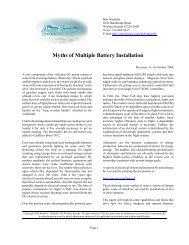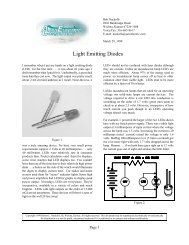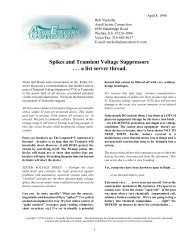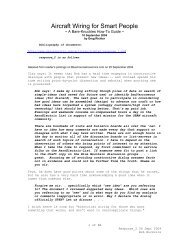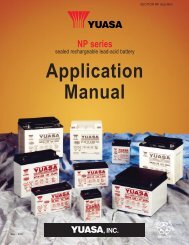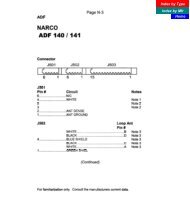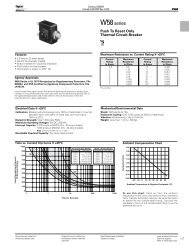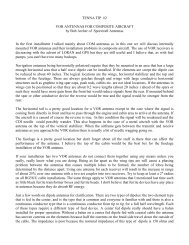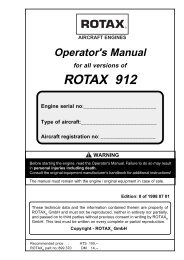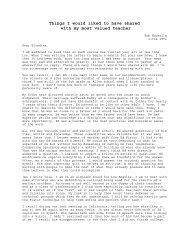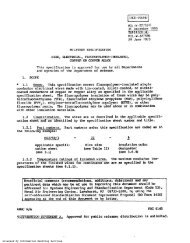G1XX0N - AeroElectric Connection
G1XX0N - AeroElectric Connection
G1XX0N - AeroElectric Connection
You also want an ePaper? Increase the reach of your titles
YUMPU automatically turns print PDFs into web optimized ePapers that Google loves.
<strong>G1XX0N</strong>GENERATOR CONTROLLER: VREG, REVERSE CURRENT, CURRENT LIMITFOR TYPE A 12 TO 50 AMP DELCO-REMY GENERATOR SYSTEMSFeatures:• Voltage Regulation, IC Sense Referenced• Electronic Controlled Generator Build-up• Electronics Field Controller/Switching• Current Limit, IC Sensed & Controlled• Reverse Current Protection• GCU induced Over Voltage (OV) Protected• Trouble-Shooting Lights on Unit• Footprint Compatible to Delco-Remy’s VRBenefits:∗ Increase Regulator Life. Not Temperature Sensitive∗ Prevents Regulator cycling at low RPM∗ Increase Regulator Life & Eliminate Regulator Noise∗ More Precise Current Limit∗ Prevents Battery Current Flowing to the Generator∗ GCU will not cause OV fault in the system∗ Reduce Trouble-Shooting Time∗ Ease of InstallationVoltage Regulation: 14.2V + 0.4V. Max Field Current: 3A.ZEFTRONICSThe Generator provides power used in charging thebattery and running other electrical systems in theaircraft. The current flowing through the field of aGenerator controls its output current. The GeneratorControl Units (GCU) have Voltage Regulation withGenerator Build-up, Current Limiter, and ReverseCurrent Protection.The Generator Build-up function allows the rotatinggenerator to build-up its output from a low residualvoltage to the system’s voltage regulation point.The Voltage Regulator (VR) controls the Generator’sfield to keep the aircraft electrical system voltage at aspecific level. This controller has a “Type A” regulatorwhich excites the field of the alternator by providingcontrolled ground to one side of the field (F), withthe other side internally connected to the armature.The Current Limiter (CL) controls the maximumoutput current the generator can produce. It turn offthe field excitation when the output current exceed theCL set point (determined by the generator’s currentrating). It allows normal field excitation when the generatoroutput is below the GCU CL set point.The Reverse Current (RC) Protection circuit blocksthe battery current from going back to the generator. Itallows current to flow only from the generator to thebattery and system.WIRINGDIAGRAMBVRGCURC & CLGB-OVRGBAFGen Out BUS BAR Bat12A-50AGenOutLight1-2ABat RelayGen SwBat SwGENSome aircraft do not have GEN warning lightPart No Volt Amp Replaces Delco-Remy P/NG1120N 14 12 1118383, 1118902G1200N 14 20 1118736, 1118904, 1119226G1250N 14 25 1118384G1350N 14 35 1118704, 1118892, 1119220G1500N 14 50 1118713, 1118884, 1119224F+Bat-The GCU’s design will cause the field current path(between the field and ground) to open if the field controldevice becomes internally ground shorted. Thismeans that the GCU will not induce Over-Voltage(OV) problem into the system. The GCU does not protectthe system against externally induced OV faults.ACBy Femi G. Ibitayo©2003, ZEFTRONICS, Tovya Group Inc<strong>G1XX0N</strong>-PIT.pub. Pg 1/41622 E. Whaley St., Longview, TX 75601. USAPh: 903-758-6661; Fax: 903-236-9766. E-mail: Tech@zeftronics.comPh: 1-800-362-8985. Web Site: www.zeftronics.comZEFTRONICSElectrical Charging Systems Solutions
<strong>G1XX0N</strong>GENERATOR CONTROLLER: TROUBLE-SHOOTING THE SYSTEMZEFTRONICSCHECKING THE RESIDUAL VOLTAGE ANDPOLARITY OF THE GENERATORConnect a voltmeter between the generator’s ARM andground. At 1300 RPM, the generator’s output or residualvoltage should be positive (greater than +1.6V).Residual Voltage __________V @ __________RPMA negative voltage reading indicates a generator thathas a reverse polarity. Do not connect the GCU to agenerator with reversed polarity.Turn off the engine and Polarize the generator byflashing the field.HOW TO FLASH THE GENERATOR’S FIELD:1. With the engine off, disconnect the GeneratorController (GCU) / Regulator2. Ground the Field wire removed from the GCUand turn on the GEN FLD switchAt the GCU: Touch the battery wire to the generator’sarmature wire 5 times for 3-5 seconds. Caution: Takesafety precaution to prevent being hurt by electricalsparks generate by touching the two wires.3. Connect a voltmeter between the generator’sARM and ground. At 1300 RPM, the generatoroutput or residual voltage should be >+1.6V.ARM Voltage ________V @ _________RPMRefer to the Trouble-Shooting Diagram1. Disconnect the GCU from the system.2. On the wires removed from the GCU, with the fieldswitch open measure the resistances at the pointsindicated by Ω. Record the values.At the Generator Measured Typical ValueARM to GND ________Ω 0.1Ω (Max)FLD to ARM ________Ω 7-10ΩFLD to GND ________Ω 7-10ΩAt the GCU MeasuredTypical ValueARM to BAT ________Ω >250ΩARM to GND ________Ω >2KΩFLD to ARM ________Ω >2KΩFLD to GND ________Ω 1Ω (Max)BUS to B ________Ω 0.1Ω (Max)If all the measurements are as specified, connect theGCU to the system and retest the Generator ElectricalCharging System (GECS).WIRINGDIAGRAMVRTrouble-ShootingDiagramVRGCURC & CLGB-OVRGCURC & CLGB-OVRGBGBBAFBAFGen Out BUS BAR BatGen Out BUS BAR BatΩΩ12A-50A12A-50AΩΩBGenOutLightΩGenOutLight1-2ABat RelayGen Sw1-2ABat RelayGen SwBat SwBat SwΩGENΩ means measure resistanceF+Bat-POST-INSTALLATION CHECK AND TESTS(WITH GCU CONNECTED)With the BAT and FLD switches on and engine off, onthe GCU the GO (Gen Out*), VR (Voltage Regulator),and CL (Current Limit) lights should be on. If the CLlight is OFF remove the GCU and check the generatorfor correct polarity and wiring.With the BAT and FLD switches on and engine runningthe generator should come on line at 1100 - 1400 RPM:the bus voltage should be 13.8V to 14.4V. At 1800 RPMthe bus voltage should remain at 13.8V to 14.4V untilabout 5 Amps below the generator’s current rating* On units that have serial numbers starting with M orN, the GO light may be off until the bus voltage exceeds12.3V-13.3V. On units with serial numbers starting withP, the GO light will come on only when the GEN voltageis less than bus voltage.F+Bat-GENSome aircraft do not have GEN warning lightAACCΩBy Femi G. Ibitayo©2003, ZEFTRONICS, Tovya Group Inc<strong>G1XX0N</strong>-PIT.pub. Pg 3/41622 E. Whaley St., Longview, TX 75601. USAPh: 903-758-6661; Fax: 903-236-9766. E-mail: Tech@zeftronics.comPh: 1-800-362-8985. Web Site: www.zeftronics.comZEFTRONICSElectrical Charging Systems Solutions
Frequently Asked Questions & TECHCARD NotesGENERATOR CONTROLLER: TROUBLE-SHOOTING THE SYSTEMZEFTRONICSNo voltage regulation or Generator not Coming on-line• With the Bat & Field switches on, engine off, andBattery voltage measured on the BAT terminal, lookfor 0-2V on the GCU FLD terminal and 0 volt on theARM. If the measured values are as specified, performthe resistance measurements called for on thispage or follow the procedure stipulated page three(TROUBLE-SHOOTING THE SYSTEM).• If the generator is coming on line after 1400 RPM,remember that some Generator overhaul shops usearmature windings with excessively high resistance.A high Armature resistance will cause the generatorto come on-line at engine speed above 1400 RPM.A 50A generator with ARM to GND resistance of0.4Ω may not come on line until the generator’s residualvoltage overcomes that internal resistance ata higher speed. That is just Ohm’s law.CAUTION & REMINDERS1. Grounding the field to see if the generator producescurrent is not a good indication that it is workingproperly. Doing so can lead to excessive systemvoltage, which may damage batteries, radios, GCU,etc. This practice will not always identify a defectivevoltage regulator because it may hide field or armaturedefects that can damage a regulator/GCU.2. DO NOT PUT POWER TO THE FIELD OF THEGENERATOR. Doing so will reverse its polarity.3. Some Generator overhaul shops use armature windingswith excessively high resistance. A high Armatureresistance will cause the generator to come onlineat engine speed above 1400 RPM.Remember, charge Gell-Cell or discharged batteriesbefore installing the GCU.WIRINGDIAGRAMVRGCURC & CLGB-OVRGBBAFGen Out BUS BAR Bat12A-50AGenOutLight1-2ABat RelayGen SwBat SwF+Bat-GENSome aircraft do not have GEN warning lightACOUR GOAL IS TO HELP YOUR SYSTEM OPERATEBETTER AND HELP YOU BETTER UNDERSTAND ITS OPERATION.ZEFTRONICSTECHCARDSCAUTION:Grounding the field to see if the generator produces currentis not a good indication that it is working properly. Doing socan lead to excessive system voltage, which may damagebatteries and radios and GCU. This practice will not alwaysidentify a defective voltage regulator because it can anddoes often hide field or armature defects.PRE-INSTALLATION TESTS.BEFORE INSTALLING THIS UNIT, PERFORM TESTS:ZEFTRONICSTECH CARDS1. Read the documents that came with the unit.2. Disconnect the current voltage regulator orGCU.3. Charge Gell-cell batteries before installing thisunit.4. Turn on the Gen Field switch5. Check the Residual Voltage and Polarity of theGenerator.a. Connect a voltmeter between the Generator’sARM and ground.b. At 1200 RPM, check the generator’s output.The output should be positive (>1.6V). If it isnegative, the generator has a reverse polarity.Do NOT connect the GCU to such generator.Turn off the engine, and flash the field.6 Measure and record the following resistancesseparately, at the generator & the wires to theGCU, list them below.At Generator At GCU Wirea. Gen Arm to Case-Ground ________Ω Ωb. Gen Fld to Case-Ground ________Ω Ωc. Gen Fld to ARM Ω Ωd Bus-GCU BAT_Ω7. If the measured values are out of the specifiedranges (listed on page 2), check your wiring,switches, circuit breakers or generator forproblems.8. If the measured values are in the specified rangeconnect the unit and perform the postinstallation tests.For tech help & tech cards,call: 903-758-6661. Fax: 903-236-9766By Femi G. Ibitayo©2003, ZEFTRONICS, Tovya Group Inc<strong>G1XX0N</strong>-PIT.pub. Pg 4/41622 E. Whaley St., Longview, TX 75601. USAPh: 903-758-6661; Fax: 903-236-9766. E-mail: Tech@zeftronics.comPh: 1-800-362-8985. Web Site: www.zeftronics.comZEFTRONICSElectrical Charging Systems Solutions


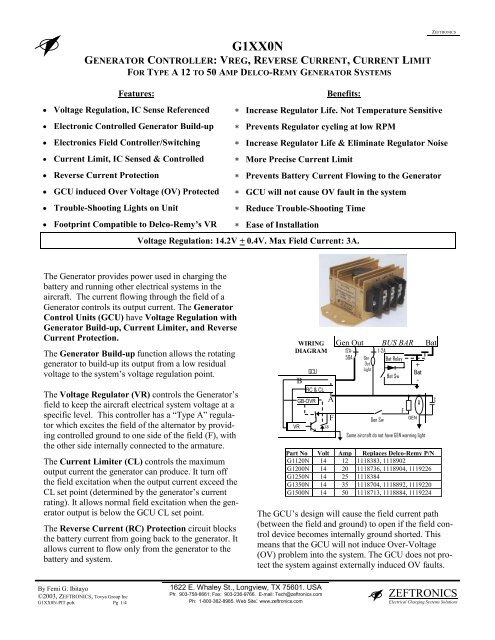
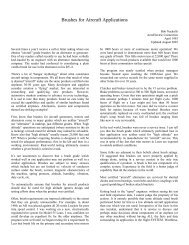
![G-Series-Ext [pdf] - Carling Technologies](https://img.yumpu.com/50918301/1/190x245/g-series-ext-pdf-carling-technologies.jpg?quality=85)

